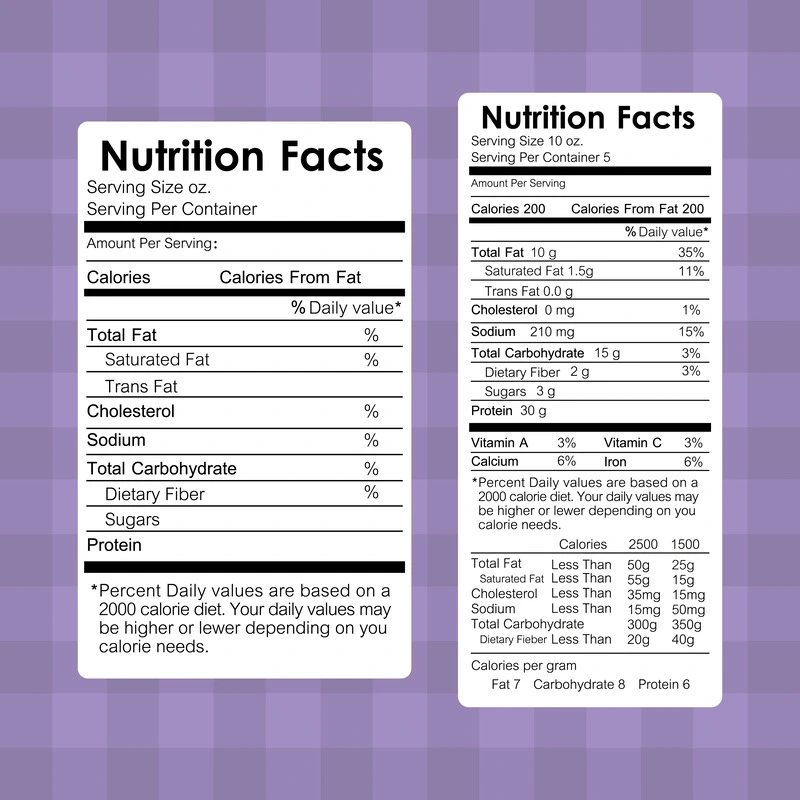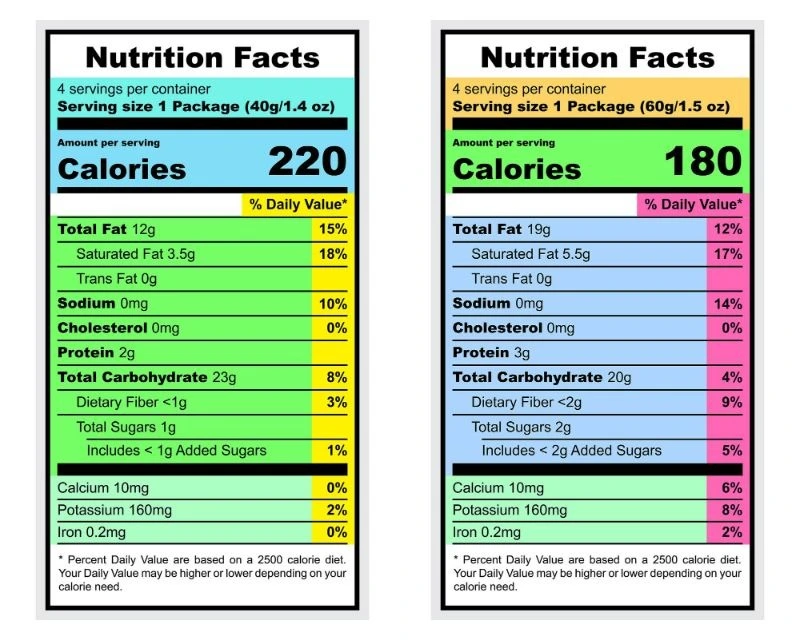Do you know what exactly goes into the food you consume daily? As individuals, we often fail to acknowledge the importance of scrutinizing food labels before purchasing. However, the inability to read and understand food labels can have dire consequences on our health. Food labels are a crucial source of information that allows us to make informed decisions about what we eat. They play a key role in maintaining the nutritional content of our diet and avoiding hidden ingredients that might affect our health. This blog post provides a comprehensive guide to understanding food labels in our quest for healthy eating.
The Anatomy of a Food Label: Breaking Down the Sections
Food labels are a valuable source of information that empowers consumers to make informed choices about the food they consume. Understanding how to read and interpret these labels is essential for promoting healthy eating habits and maintaining overall well-being. Each food label comprises several key sections, each serving a specific purpose in providing a comprehensive picture of the product's nutritional profile and potential health implications.
a. Product Name: The product name serves as the primary identifier of the specific food item or beverage. It allows consumers to quickly recognize and differentiate the product from similar items on the market. While the product name provides valuable information about the type of food, it is important to note that it does not give insights into the nutritional content or health effects of the product.
b. Nutrition Facts: Among the most critical components of a food label, the nutrition facts section presents essential information about the product's macronutrient and micronutrient content in a standardized serving size. Understanding the values provided in the nutrition facts section enables consumers to evaluate the product's nutritional content and compare different options to make health-conscious choices.
c. Ingredients List: The ingredients list offers detailed information about all the components used to manufacture the food product, listed in descending order by weight. Common allergens, such as peanuts, tree nuts, soy, dairy, wheat, eggs, fish, and shellfish, must be clearly indicated in the ingredients list to safeguard those with food allergies or intolerances. By reading the ingredients list, consumers can become more aware of the presence of artificial colors, flavors, preservatives, and other additives that might not align with their health goals. Choosing products with simple, recognizable ingredients is often recommended for promoting a wholesome diet.
d. Allergen Information: The allergen information section specifically highlights the presence of common allergens in the product. This information is paramount for individuals with food allergies or intolerances, as even trace amounts of allergens can trigger severe allergic reactions. Food manufacturers must clearly indicate the presence of allergens within the ingredients list or as a separate section. Vigilance in reading the allergen information can significantly reduce the risk of accidental consumption and help individuals with food allergies maintain a safe and healthy diet.
e. Health Claims: Food manufacturers often use health claims as marketing tactics to promote their products. These claims may include statements like "low-fat," "sugar-free," "gluten-free," "all-natural," and more. While these claims can be beneficial for consumers seeking specific dietary options, it is crucial to understand their true meaning and relevance to individual nutritional needs and health goals. Consumers should exercise caution and skepticism when encountering health claims on food labels. Sometimes, products labeled as "low-fat" or "sugar-free" may compensate for reduced fat or sugar content with higher levels of unhealthy ingredients. Relying on the overall nutritional information and ingredient list provides a more accurate assessment of a product's healthfulness.

Decoding Nutrition Facts: Key Nutrients and Daily Values
The nutrient content is one of the most critical aspects we look for in a food label. Understanding these nutrients and their daily value percentages is crucial for assessing the product's contribution to our overall diet and making informed choices for our health.
Calories: The calorie content listed on the food label represents the amount of energy provided by one serving of the food. Monitoring calorie intake is essential for weight management and overall health. Consuming more calories than our body needs can lead to weight gain while consuming fewer calories than required can result in energy deficiency and potential nutrient deficiencies. The daily calorie value is based on a 2,000-calorie diet, the general reference for nutrition labeling. Consuming 2,000 calories daily is considered appropriate for many adults to maintain a healthy weight. However, individual calorie needs vary based on factors such as age, gender, activity level, and overall health goals. It's essential to consult with a healthcare professional or registered dietitian to determine personalized calorie requirements.
Fats: The total fat content is divided into saturated fats and trans fats. Saturated fats, found in animal-based products and some plant oils, can raise LDL cholesterol levels and increase the risk of heart disease when consumed in excess. Trans fats, often found in partially hydrogenated oils used in processed foods, are considered unhealthy fats. They should be avoided altogether as they have been linked to various health problems, including an increased risk of heart disease. The American Heart Association recommends that saturated fat intake should be limited to less than 10% of total daily calories, and trans fat consumption should be as low as possible since it has no known safe level of intake.
Cholesterol: Cholesterol is a type of fat found in animal-based foods. High cholesterol intake can harm heart health, contributing to plaque formation in the arteries and increasing the risk of heart disease. It is essential to limit cholesterol consumption, especially for individuals with cholesterol-related conditions or a history of heart problems. The Dietary Guidelines for Americans recommend consuming less than 300 mg of cholesterol daily. For those with high blood cholesterol levels or a history of heart disease, limiting cholesterol intake to 200 mg per day is recommended. However, individual sensitivity to dietary cholesterol may vary, and it's best to consult with a healthcare professional for personalized nutritional advice.
Sodium: High sodium intake is associated with increased blood pressure and a higher risk of cardiovascular disease. Monitoring sodium content is important, especially for individuals with hypertension or kidney issues. Reducing sodium intake can help lower blood pressure and reduce the risk of heart disease and stroke. The American Heart Association suggests an ideal limit of 1,500 mg daily for sodium intake, especially for individuals with high blood pressure, heart disease, or other cardiovascular issues. However, individual sodium needs may vary, and consulting with a healthcare professional or registered dietitian is recommended for personalized sodium recommendations.
Carbohydrates: Carbohydrates include both sugars and dietary fiber. It's crucial to differentiate between the product's added sugars and naturally occurring sugars. Added sugars, commonly found in sugary snacks and beverages, contribute to empty calories and can increase the risk of obesity and type 2 diabetes when consumed in excess. On the other hand, dietary fiber is beneficial for digestion, helps maintain stable blood sugar levels, and promotes a feeling of fullness, aiding in weight management. There is no specific daily value for carbohydrates on the food label. However, the "Total Carbohydrates" section includes "Dietary Fiber" and "Total Sugars" subcategories, which provide helpful information. The American Heart Association recommends that added sugars should not exceed 10% of total daily calories. For a 2,000-calorie diet, this equates to about 50 grams (12 teaspoons) of added sugars per day. Individual carbohydrate and fiber needs may vary, and it's essential to consider individual health goals when making dietary choices.
Protein: Protein is essential for building and repairing tissues, supporting the immune system, and producing enzymes and hormones. Adequate protein intake is crucial for overall health, especially for individuals with active lifestyles, athletes, or those seeking to build and maintain muscle mass. Protein needs vary based on factors such as age, gender, activity level, and overall health status. The general recommendation is to consume 0.8 grams of protein per kilogram of body weight per day. However, athletes and individuals engaging in intense physical activity may require higher protein intake to support muscle recovery and growth.
Understanding the significance of these nutrients empowers consumers to make better dietary choices and tailor their eating habits to meet their specific health goals and nutritional needs.
Calorie Counting and Beyond: Additional Nutritional Information
Beyond macronutrients, food labels provide additional nutritional information that is crucial in making healthy food choices. This section focuses on various nutrients and their impact on our health.
a. Dietary Fiber: High dietary fiber intake supports digestive health, promotes regular bowel movements, and reduces the risk of gastrointestinal disorders. Additionally, dietary fiber helps regulate blood sugar levels and contributes to a feeling of fullness, which aids in weight management.
b. Sugars: Excessive added sugars in the diet have been linked to an increased risk of obesity, type 2 diabetes, and dental problems. Understanding the amount of added sugars in a product helps consumers make choices that align with their health goals and reduce their overall sugar intake.
c. Vitamins and Minerals: Some food labels provide information about the presence of essential vitamins and minerals in the product. These nutrients are vital for various bodily functions, such as immune function, bone health, and energy metabolism. Being aware of the vitamins and minerals in a product can guide consumers in selecting foods that contribute to overall well-being.
d. Micronutrients: Micronutrients, including vitamins and minerals, are essential for maintaining overall health and preventing nutrient deficiencies. Understanding the importance of micronutrients helps individuals prioritize a balanced diet and consider the nutritional content of their food choices.
By considering these factors, consumers can make informed decisions about their food selections and support their nutritional goals. It is crucial to remember that individual dietary needs vary, and consulting with a registered dietitian or healthcare professional can provide personalized guidance for optimal nutrition and well-being.
Understanding Common Abbreviations for Nutritional Information
Food labels often contain various abbreviations that provide essential information about the product's nutritional content and characteristics. Here are some common abbreviations found on food labels:
DV: Daily Value - DV represents the percentage of a specific nutrient present in one serving of the food, based on the daily recommended intake for a 2,000-calorie diet.
%DV: Percent Daily Value - %DV indicates the contribution of a nutrient in one serving towards the total daily recommended intake for that nutrient.
kcal: Kilocalories - Commonly referred to as calories, kcal denotes the amount of energy provided by one serving of food.
g: Grams - Used to measure the weight or quantity of macronutrients (such as carbohydrates, proteins, and fats) and some micronutrients (such as dietary fiber).
mg: Milligrams - Represents the quantity of micronutrients, like vitamins and minerals, in smaller amounts.
IU: International Units - Used to measure the potency of certain vitamins, like vitamin A, D, and E, in dietary supplements.
RDI: Reference Daily Intake - Provides the daily recommended intake of a nutrient based on a 2,000-calorie diet.
AI: Adequate Intake - Used when there is insufficient scientific evidence to establish a Recommended Dietary Allowance (RDA), representing a nutrient intake level that is likely adequate for most individuals.
GMO: Genetically Modified Organism - Indicates whether the product contains genetically modified ingredients.
USDA: United States Department of Agriculture - Refers to the government agency responsible for regulating food labeling and safety.
FDA: Food and Drug Administration - The agency responsible for regulating food labeling and ensuring the safety of food products in the United States.

Serving Sizes: Unraveling Portion Control on Food Labels
Understanding and applying portion control is vital for maintaining a healthy diet and managing calorie intake. However, food labels can sometimes need to be more accurate, making it challenging for consumers to keep track of the number of calories they consume. In this section, we delve into the importance of serving sizes in controlling calorie intake and guide how to interpret the serving size information on food labels.
- Serving Size Explanation: The serving size listed on the food label represents the standardized portion for which the nutritional information is provided. It acts as a reference point for consumers to understand the nutrient content and calorie count in a single product serving. Paying close attention to the serving size is crucial for accurately calculating nutrient intake from the product.
Example: If a serving size for a bag of chips is 1 ounce (28 grams), and the label indicates that it contains 150 calories, consuming 2 ounces (56 grams) would mean consuming 300 calories.
It is essential to recognize that the serving size might differ from what individuals typically consume in a single sitting. For instance, a package of cookies may have a serving size of two cookies, but it is not uncommon for people to consume more than that in one sitting. Knowing the actual serving size versus what is considered a typical serving can help consumers better control their calorie intake and make more informed dietary choices.
- Portion Control: Understanding serving sizes is essential to effective portion control. By being mindful of the recommended serving size, individuals can avoid overeating and maintain a balance between the nutrients they consume and their energy needs. Portion control is particularly vital for weight management and overall health, as excessive calorie intake can lead to weight gain and associated health issues.
Example: When serving pasta for dinner, following the recommended serving size of 1 cup cooked (about the size of a tennis ball) can help prevent overindulgence and manage calorie intake.
To practice portion control effectively, it can be helpful to use measuring tools, such as measuring cups or a food scale, to accurately gauge the appropriate serving size. Additionally, paying attention to hunger and fullness cues can aid in recognizing when to stop eating and preventing unnecessary calorie consumption.
- Pay Attention to Servings Per Container: Food packages often contain multiple servings. However, consumers may unknowingly consume the entire package in one sitting, especially when the contents are perceived as a single serving. Awareness of the total servings per container is essential to prevent excessive calorie intake.
Example: A granola bar box may have three servings, but it's easy to consume the entire package, resulting in three times the stated calorie and nutrient intake.
Misinterpreting servings per container can lead to unintended overconsumption of calories and nutrients. For instance, a beverage container might appear as one serving, but a closer examination of the label might reveal that it contains two or more servings. Consuming the entire container would then double or triple the calorie and nutrient intake. By carefully reading the label and understanding the total servings per container, consumers can make conscious decisions about portion sizes and manage their calorie intake more effectively. It is important to remember that individual calorie and nutrient needs vary based on factors such as age, sex, activity level, and health status, so consulting with a registered dietitian or healthcare professional can provide personalized guidance on portion control and dietary recommendations.
Ingredients List Demystified: Spotting Hidden Additives
The ingredients list on food labels is a vital source of information about the product's composition, providing transparency about the various components used. Understanding and scrutinizing this list is essential for making informed choices promoting health and well-being.
a. Understanding Ingredients: This section enlightens us about common ingredients found in food products and their potential health implications. Some ingredients are natural and offer nutritional benefits. For example, whole grains provide fiber and essential nutrients, while natural sweeteners like honey or maple syrup can add sweetness without refined sugars. On the other hand, certain additives and artificial ingredients can be detrimental to health. Artificial colors, flavors, and some preservatives have been linked to adverse effects, such as hyperactivity in children or allergic reactions. By grasping the significance of these ingredients, we can make informed decisions and opt for products with more healthful components.
Example: A granola bar with oats, nuts, and dried fruits is a healthier option than a similar bar filled with artificial colors, flavors, and high levels of added sugars.
b. Avoiding Harmful Additives: Many processed foods contain additives and preservatives that might negatively affect our health. Artificial sweeteners like aspartame or sucralose have raised concerns about potential metabolic issues. High-fructose corn syrup, a common sweetener in many processed products, has been linked to obesity and other health problems. Excessive amounts of sodium and certain preservatives in processed foods may contribute to hypertension and other health issues. Awareness of these additives empowers us to actively avoid products containing them and opt for whole foods or minimally processed alternatives.
Example: Choosing a tomato sauce with no added artificial sweeteners or excessive sodium is a healthier option than one loaded with high-fructose corn syrup and preservatives.
c. Identifying Allergens: The ingredients list is a critical tool for identifying potential allergens in the product for individuals with food allergies or intolerances. The list must clearly indicate common allergens, such as peanuts, tree nuts, soy, dairy, wheat, eggs, fish, and shellfish. Carefully examining the ingredients list helps ensure the safety of those with specific dietary restrictions or health conditions, preventing potential allergic reactions or adverse health effects.
Example: For someone with a peanut allergy, checking the ingredients list on a snack bar for any traces of peanuts or peanut-derived ingredients is essential to avoid a dangerous allergic reaction.
By understanding the ingredients list and spotting hidden additives, we can make more informed food choices that align with our health goals. Being conscious of what we consume empowers us to prioritize nutritious options, steer clear of harmful additives, and cater to specific dietary needs or restrictions effectively. Ultimately, reading and interpreting the ingredients list allows us to take control of our diet and well-being.

Navigating Allergen Warnings: Protecting Yourself from Harm
Food labels play a crucial role in helping us identify potential allergens present in food products, enabling informed decision-making for individuals with food allergies or intolerances. This section will focus on the importance of allergen warnings, how to identify allergens on labels, and what to do in case of accidental consumption.
a. Common Allergens: This section will provide a comprehensive list of common food allergens that individuals should be vigilant about. Common allergens include peanuts, tree nuts (such as almonds, cashews, and walnuts), soy, dairy (including milk and its derivatives), wheat (gluten-containing grains), eggs, fish, and shellfish. Awareness of these allergens empowers consumers to recognize potential risks and make safe choices.
b. Reading Allergen Warnings: Understanding how allergens are indicated on food labels is essential to identify products that may pose risks to individuals with allergies. Allergen warnings are often highlighted using specific formatting, such as bold letters or uppercase text, to draw attention to the presence of allergens. Additionally, certain food manufacturers provide clear statements like "contains peanuts" or "may contain traces of nuts" to alert consumers about potential cross-contamination risks.
c. Cross-Contamination Risks: Some food products may not contain allergens in their ingredients list but can still pose a risk due to cross-contamination during processing. Cross-contamination occurs when an allergen inadvertently comes into contact with a product during production or packaging, leading to the transfer of trace amounts of the allergen. Understanding these risks is crucial, especially for individuals with severe allergies, as even tiny amounts of allergens can trigger allergic reactions.
Some manufacturers implement stringent measures in their facilities to mitigate cross-contamination risks, such as dedicated equipment and production lines for allergen-free products. Food labels may also include statements like "manufactured in a facility that processes peanuts" to inform consumers about the potential for cross-contamination.
By being informed about allergen warnings and cross-contamination risks, individuals with food allergies can confidently navigate food labels, make safe choices, and protect themselves from potential harm. It is essential for those with severe allergies to be proactive in reading labels and seeking clarity from manufacturers if needed. Additionally, individuals with allergies should inform friends, family, and caregivers about their dietary restrictions to ensure a safe and supportive environment. As allergen information and cross-contamination risks can vary, it is advisable to stay updated on food labeling regulations and consult with healthcare professionals or registered dietitians for personalized guidance on managing food allergies.
Unveiling Health Claims: Making Informed Food Choices
Food manufacturers often use health claims as marketing strategies to promote their products, but not all claims are accurate or indicate a product's nutritional quality. Understanding these claims is crucial for making informed food choices. A "low-fat" claim may indicate reduced fat content, but it doesn't necessarily mean the product is healthier overall. Similarly, a "sugar-free" claim implies no added sugars, but the product may still be high in calories from other sources. "Gluten-free" products benefit those with celiac disease or gluten sensitivity but may not be healthier for everyone. Claims like "high in protein" are helpful for individuals seeking to boost protein intake, but it's also essential to consider other nutrients. Spotting misleading claims is necessary, as some products may carry health halos based on partial or misleading information, such as being labeled "organic" or "superfood." Relying on reputable sources and scientific research rather than marketing claims when making food choices is vital to determining a product's nutritional value and potential health benefits. If you need clarification on a health claim, you can do your research by visiting reputable websites or talking to a healthcare professional. For example, you can check the websites of the FDA or USDA for information about health claims that are allowed on food labels. By staying informed and critically evaluating food labels, consumers can navigate the marketing noise and prioritize their health and well-being, making food choices that align with their unique nutritional needs and goals. Seeking guidance from registered dietitians or healthcare professionals can provide personalized support in making optimal food choices based on individual health requirements.
Conclusion
Understanding the significance of food labels and their critical information is imperative for promoting healthy eating habits and overall well-being. Reading food labels carefully and correctly is crucial for making informed decisions about what we eat, and it becomes even more critical when we have medical conditions that require us to maintain a healthy diet. Furthermore, in your journey towards maintaining optimal health and wellness, Cura4U plays a vital role as a reliable healthcare partner. Cura4U offers comprehensive health services, including access to certified healthcare professionals and doctor consultations. When managing specific dietary needs or addressing health concerns related to food allergies, intolerances, or medical conditions, Cura4U connects you with experienced healthcare providers who can provide personalized guidance and support. Through Cura4U, you gain access to a wealth of health-related knowledge, medical resources, and tools, making it easier to make informed decisions about your family's health and dietary choices. Remember, when it comes to health and well-being, safety comes first. Stay proactive, stay informed, and let Cura4U be your trusted partner on your journey to better health through informed dietary decisions and expert medical guidance.
Our clinical experts continually monitor the health and medical content posted on CURA4U, and we update our blogs and articles when new information becomes available. Last reviewed by Dr. Tayyab Saeed Akhter on August 2 nd, 2023.
References
Food Labels | CDC- https://www.cdc.gov/diabetes/managing/eat-well/food-labels.html
Changes to the Nutrition Facts Label | FDA- https://www.fda.gov/food/food-labeling-nutrition/changes-nutrition-facts-label
How to Understand and Use the Nutrition Facts Label | FDA- https://www.fda.gov/food/new-nutrition-facts-label/how-understand-and-use-nutrition-facts-label
Understanding Food Labels | The Nutrition Source | Harvard T.H. Chan School of Public Health- https://www.hsph.harvard.edu/nutritionsource/food-label-guide/
Food labels - NHS (www.nhs.uk)- https://www.nhs.uk/live-well/eat-well/food-guidelines-and-food-labels/how-to-read-food-labels/
How To Read Food and Beverage Labels | National Institute on Aging (nih.gov)- https://www.nia.nih.gov/health/how-read-food-and-beverage-labels
Food labelling - Food and nutrition | NHS inform- https://www.nhsinform.scot/healthy-living/food-and-nutrition/food-packaging/food-labelling
Reading Food Labels | ADA (diabetes.org)- https://diabetes.org/healthy-living/recipes-nutrition/reading-food-labels
Food Labelling | FAO | Food and Agriculture Organization of the United Nations- https://www.fao.org/food-labelling/en/
The Basics of the Nutrition Facts Label (eatright.org)- https://www.eatright.org/health/wellness/nutrition-panels-and-food-labels/the-basics-of-the-nutrition-facts-label
How to read food labels: MedlinePlus Medical Encyclopedia- https://medlineplus.gov/ency/patientinstructions/000107.htm
Understanding Food Nutrition Labels | American Heart Association- https://www.heart.org/en/healthy-living/healthy-eating/eat-smart/nutrition-basics/understanding-food-nutrition-labels













